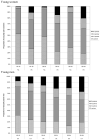A tale of two countries: rethinking sexual risk for HIV among young people in South Africa and the United States
- PMID: 21856514
- PMCID: PMC3159866
- DOI: 10.1016/j.jadohealth.2010.10.002
A tale of two countries: rethinking sexual risk for HIV among young people in South Africa and the United States
Abstract
Purpose: To compare the sexual behaviors of young people in South Africa (SA) and the United States (US) with the aim to better understand the potential role of sexual behavior in HIV transmission in these two countries that have strikingly different HIV epidemics.
Methods: Nationally representative, population-based surveys of young people aged 18-24 years from SA (n = 7,548) and the US (n = 13,451) were used for the present study.
Results: The prevalence of HIV was 10.2% in SA and <1% in the US. Young women and men in the US reported an earlier age of first sex than those in SA (mean age of coital debut for women: US [16.5], SA [17.4]; for men: US [16.4], SA [16.7]). The median number of lifetime partners is higher in the US than in SA: women: US (4), SA (2); men: US (4), SA (3). The use of condom at last sex is reported to be lower in the US than in SA: women: US (36.1%), SA (45.4%); men: US (48%), SA (58%). On average, young women in SA report greater age differences with their sex partners than young women in the US.
Conclusion: Young people in the US report riskier sexual behaviors than young people in SA, despite the much higher prevalence of HIV infection in SA. Factors above and beyond sexual behavior likely play a key role in the ongoing transmission of HIV in South African youth, and thus should be urgently uncovered to develop maximally effective prevention strategies.
Copyright © 2011 Society for Adolescent Health and Medicine. Published by Elsevier Inc. All rights reserved.
Figures



Comment in
-
The wrong place at the wrong time: geographic disparities in young people's HIV Risk.J Adolesc Health. 2011 Sep;49(3):227-9. doi: 10.1016/j.jadohealth.2011.07.004. J Adolesc Health. 2011. PMID: 21856512 Free PMC article. No abstract available.
-
Sexual behavior, HIV and South African youth.J Adolesc Health. 2012 Feb;50(2):207-8; author reply 209-10. doi: 10.1016/j.jadohealth.2011.09.010. J Adolesc Health. 2012. PMID: 22265120 No abstract available.
-
A tale of two epidemics within TWO countries.J Adolesc Health. 2012 Feb;50(2):208-9; author reply 209-10. doi: 10.1016/j.jadohealth.2011.09.016. J Adolesc Health. 2012. PMID: 22265121 No abstract available.
References
Sources
-
- U.S. Department of Education. National Center for Education Statistics Digest of Education Statistics, 2005. 2006 (NCES 2006-030), Chapter 1.
-
- U.S. Department of Education. National Center for Education Statistics The Condition of Education 2007. 2007 (NCES 2007-064), Indicator 23.
References
-
- Pettifor A, Rees H, Kleinschmidt I, et al. Young people's sexual health in South Africa: HIV prevalence and sexual behaviours from a nationally representative household survey. AIDS. 2005;19:1525–1534. - PubMed
-
- Asthana A. Africa's fata sexual culture spreads AIDS. The Observer International. 2005 June 19;
-
- Abrahams B. Promiscuity in Africa. Suite 101.com. 2007. http://aids-hivtreatment.suite101.com/article.cfm/promiscuity_in.
-
- Timberg C. Speeding HIV's Deadly Spread. Washington Post. 2007 March 2;
Publication types
MeSH terms
Grants and funding
LinkOut - more resources
Full Text Sources
Medical

